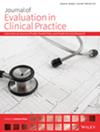Psychometric Evaluation of the Icelandic Version of the Modified Dynamic Gait Index for Community-Dwelling Older Adults With Balance Impairments
Abstract
Rationale
Optimal mobility is crucial for healthy aging, particularly among older adults with balance impairments. This research examines the psychometric properties of the modified Dynamic Gait Index (mDGI) translated into Icelandic, highlighting its suitability for evaluating mobility in this demographic group and within the context of healthy aging. Addressing the scarcity of international psychometric research on the mDGI, this study contributes to the translation of geriatric outcome measures into different languages, enhancing clinical applications and international research.
Aim
To assess the reliability and validity of the mDGI among Icelandic older adults experiencing balance impairments.
Methods
This methodological study included 30 participants, aged 67–91 years, receiving outpatient physical therapy for balance impairments. The participants completed two mDGI assessments 4–7 days apart, and additional assessments using the 10-meter walking test (10MWT), Timed Up and Go (TUG), Activities-specific Balance Confidence (ABC) scale, and Short Form Health Survey (SF-36) subscales. Analysis included evaluating the mDGI's total scale and subscales' reliability and validity using Intraclass Correlation Coefficient (ICC3,1), Standard Error of Measurement (SEM), Cronbach's alpha, and Spearman's rho.
Results
The mDGI demonstrated high relative reliability (ICC3,1 = 0.95 for total mDGI; 0.73–0.92 for all subscales) and strong absolute reliability (SEM for total mDGI = 1.32; two subscales = 1.17–1.43). Internal consistency was robust (alpha for total mDGI = 0.9; two subscales = 0.86–0.89). Construct validity was confirmed by mDGI's correlations with 10MWT, TUG, and SF-36 social and physical functioning subscales. No floor or ceiling effects were observed in mDGI total scores.
Conclusion
The Icelandic version of the mDGI provides reliable and valid measures for evaluating balance and gait in older adults with balance impairments. Its sound psychometric properties support its use in similar demographic settings globally, providing a reliable tool for geriatric care practitioners and researchers worldwide.


 求助内容:
求助内容: 应助结果提醒方式:
应助结果提醒方式:


